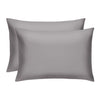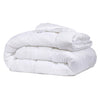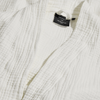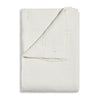The Daily Miracle
Is Sleeping on the Floor Good for You?
Published
January 29, 2024
Author
Bridget Reed

When you imagine the most comfortable place to sleep, a plush, cozy bed adorned with its plush mattress and fluffy pillows might naturally be the first thing that comes to mind. But although the mental image may be nice, it’s possible this dream bed setup isn’t the best.
Across the globe, various cultures have embraced the simplicity of resting on the ground. It's a practice that goes beyond mere necessity, often intertwined with principles of health and wellness.
But here's the million-dollar question: can replacing your cushioned mattress with the unyielding firmness of a hard surface lead to a more restorative sleep? Is there wisdom in this age-old practice that we could benefit from rediscovering in our modern comfort-laden world?
Prepare to challenge everything you thought you knew about a good night’s sleep.
Sleeping on the Floor: The Basics
The concept of floor sleeping is deeply rooted in various cultural practices around the world. In Japan, for instance, the tradition of sleeping on tatami mats is an integral part of a lifestyle that values simplicity and harmony with nature.
This minimalist approach to sleep isn't just about cultural heritage. It's a deliberate choice for many, driven by the pursuit of physical well-being and simplicity. The question then arises: could a firmer surface, akin to a hard floor, provide better alignment and support for our bodies during sleep?
This exploration takes us beyond the realm of comfort, delving into the impact of sleeping surfaces on our overall health. We'll investigate how the rigidity of a firmer mattress or the unyielding nature of a floor can affect our sleeping position, potentially enhancing sleep quality and influencing long-term health.
Are There Benefits to Floor Sleeping?
Many advocates of this practice report not only an alleviation of back pain but also an overall improvement in musculoskeletal health. Contrary to initial assumptions, a hard surface may offer more than just better spinal alignment.
It encourages the body to maintain natural postures, potentially easing chronic issues like lower back pain. Moreover, the firmness of the floor can promote better blood circulation and reduce the risk of scoliosis.
Beyond the spine, joint pain and sciatica sufferers often report significant relief, as the even distribution of body weight on a firm surface helps to reduce pressure points and improve alignment. This balanced distribution of weight is especially beneficial for side sleepers, who may find that a hard sleeping surface prevents the awkward angles often caused by a mattress that is too soft.
Comparing Sleeping Surfaces
A soft mattress, with its plush, enveloping feel, might seem like the epitome of comfort. Still, it may not adequately support the body's natural alignment, especially for back and stomach sleepers.
No matter how inviting it looks, a soft mattress may actually be contributing to back pain. On the other hand, a medium-firm mattress strikes a balance between softness and support, often recommended by experts for its ability to maintain spinal alignment.
With its contouring properties, memory foam can be a boon for side sleepers, adapting to the body's curves and reducing pressure on hips and shoulders. However, memory foam's heat-retentive properties might not be suitable for those who tend to overheat at night.
Then there's the firm mattress — often overlooked but surprisingly beneficial for those with certain health conditions or preferences for a harder sleeping surface. If you think your body may benefit from something like sleeping on the floor, but the idea of it isn’t so appealing, investing in a firmer mattress may offer you similar benefits while still maintaining a cozier feel.
The Downsides of Floor Sleeping
While floor sleeping has its advocates, it's important to consider its potential downsides. Proximity to the ground can increase exposure to allergens, dust mites, and even cold drafts, which could be problematic for those with allergies or respiratory issues.
This increased exposure can lead to allergic reactions or exacerbate existing health conditions, making maintaining a clean and dust-free sleeping area essential. Additionally, for those unaccustomed to the firmness of the floor, the initial transition can be quite uncomfortable, potentially leading to soreness or stiffness.
This adjustment period can be challenging for people of all ages, but particularly for older adults or those with limited mobility. Sleeping on a hard floor in colder climates can be less than ideal.
The floor remains cool or even cold as heat rises, which might be refreshing in hot weather but can be uncomfortable in cooler temperatures. This can affect the body's ability to maintain a consistent temperature throughout the night, potentially disrupting sleep.
Making Floor Sleeping Work for You
Floor sleeping can be a rewarding experience, but comfort is key to making it sustainable. For those new to this practice, easing into it with the right accessories can make all the difference.
A futon can provide the necessary cushioning while maintaining the firmness of floor sleeping. A thin pillow with a lush pillowcase, preferably one that supports the neck without elevating the head excessively, can complement this setup. For those who find the floor too firm, a topper can add a layer of comfort without sacrificing the benefits of a hard surface.
That said, even if you’re not necessarily sleeping on a bed, you shouldn’t skimp on bedding. Particularly if you have concerns about cleanliness when it comes to floor sleeping, our Miracle Made® Sleep Set is ideal.
Not only are our sheets soft and comfortable, but they're made with antibacterial silver, which helps to cut down on bacterial growth, leading to fresher, cleaner sheets no matter where you’re sleeping.
Special Considerations for Floor Sleeping
The transition to floor sleeping should be a personalized journey, taking into account individual body types and sleeping habits. For example, side sleepers might need additional cushioning around the hips and shoulders, whereas back sleepers may require extra lumbar support.
It’s crucial to listen to your body and adjust your sleeping setup accordingly to prevent any discomfort or poor posture. The firmness of the surface should support the body's natural alignment without causing pressure points or stiffness.
The sleeping environment plays a crucial role as well. While a tatami mat provides a unique blend of firmness and give, it might not be suitable for all climates or individual preferences.
The room temperature, humidity, and air quality can all impact the comfort and effectiveness of floor sleeping. It's essential to create an environment that fosters restful sleep,
This can include adjusting the room's temperature, using a comforter that helps to regulate your body temperature, using a humidifier, or ensuring proper ventilation. By considering these factors, one can optimize their floor sleeping experience and potentially reap greater health benefits.
Laying the Groundwork for Great Sleep
Sleeping on the ground may seem unusual if it’s not part of your routine or culture, but it’s a lifestyle choice that offers numerous health benefits. Whether it leads to improved spinal alignment, better blood circulation, or simply a deeper connection to minimalist living, floor sleeping has the potential to transform your sleep experience.
However, it’s important to recognize that it's not a universal remedy. Individual preferences, health conditions, and lifestyle factors play significant roles in determining whether this practice is suitable. With the right approach and adjustments, you may discover that floor sleeping is the secret to achieving the profound, restorative sleep you've been seeking.
Sources:
Antibacterial Silver | National Library of Medicine






























